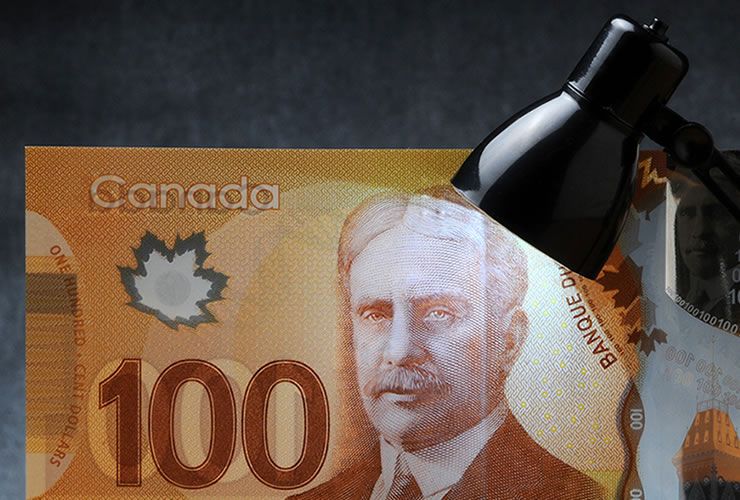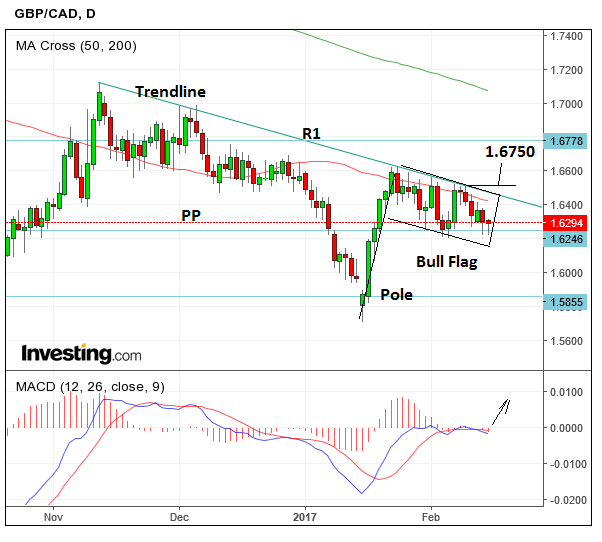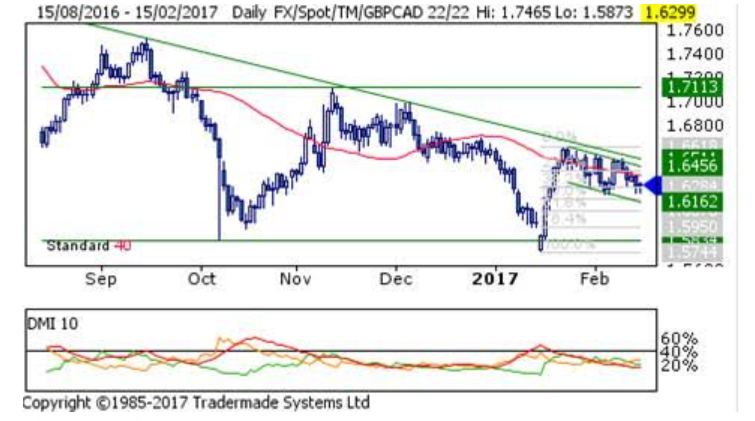GBP/CAD Poised for Gains as Bull Flag Pattern Forms

GBP/CAD has been pushing up against a trendline in the 1.65s and although it has been repulsed following successive attempts to break above, we still see a slight bias towards more upside and therefore an eventual break higher emerging.
Looked at in another way, the steep rally up from the January lows followed by the box-like consolidation phase has formed a bull flag pattern, which is likely to breakout higher and rise roughly the same distance as the length of the ‘pole’.
For confirmation of a break higher we would be looking for a move above the 1.6500 highs.
Such a break would be expected to reach as high as 1.6750 just below where resistance kicks in from the R1 monthly pivot.
Analysts at Scotiabank see things similarly.
"GBPCAD is little changed within the recent consolidation range (potential bull flag). The GBP has found support recently around the 38.2% retracement of the sharp January rally (1.6284) and the GBP appears to be attracting bids in the mid/upper 1.62s again today," said Scotia's Shaun Osborne in a note seen by PSL.
But his conclusions are different, as he sees a risk of more downside because of lacklustre, longer-term momentum studies.
"We think the GBP remains at risk of more, corrective, weakness towards the 1.60 area possibly before the uptrend can resume," said Osborne.
News and Data for the Canadian Dollar in the Second Half of the Week
Wednesday saw an unexpected rise in Canadian data in the form of manufacturing Sales, which surged by 2.3% month-on-month in December, a much higher result than the 0.2% forecast.
On Friday. February 17 at 13.30 GMT we see the release of Foreign Securities Purchases, and although this has an impact on Current Account, will probably not move the markets exceptionally.
The outlook appears less uncertain since an apparently amicable meeting between the Canadian Prime Minister Justin Trudeau and Donal Trump, in which the US President said the NAFTA free trade agreement would only be marginally renegotiated.
News and Data for Sterling
The Pound weakened on Wednesday following worse than expected average earnings data which came out at 2.6% instead of the 2.8% expected (and 2.8% previously), in January.
Earnings are indicative of inflation and therefore future monetary policy from the Bank of England (BOE).
A rise in earnings leads to higher inflation, leads to the BOE raising interest rates and this pushes up the Pound because more foreign investors are likely to transfer their capital to the UK to receive the higher interest return being offered there.
Currently the usual relationship between inflation and earnings, however, appears to have broken down, because inflation is being pushed higher, not by more spending, but by the weak Pound, which has pushed up the cost of imports.
The slowing wage recovery is weakening the Pound because it could slow economic growth down as people will have less spare cash to spend due to wages not rising as fast as inflation.
“The trouble is inflation is rising at an anti-Goldilocks rate - neither bad enough nor mild enough. It's not fast enough for the Bank of England to hike interest rates, nor slow enough to stop economists fretting about its growth-sapping erosion of consumers’ buying power.
“With average wages now rising only a shade faster than prices, the wheels could fall off the consumer boom that has so far powered the UK economy through much of the post-referendum turbulence,” said David Lamb, commenting on the data, who is head of Dealing at FEXCO.
This feeds into the next major release for the Pound, on Friday, February 17, when Retail Sales for January is published at 09.30 GMT.
Analysts are expecting a slowdown due to wages not rising as quickly as previously and therefore people consuming less.
Of course, the rising cost of imports may also be putting shoppers off due to rising price-tags.
Nevertheless, consensus estimates are for Retail Sales year-on-year (yoy) to show a rise of 3.5%, and 1.0% month-on-month (mom).
Core Retail Sales are forecast to rise by 3.8% yoy and 0.7% mom.






